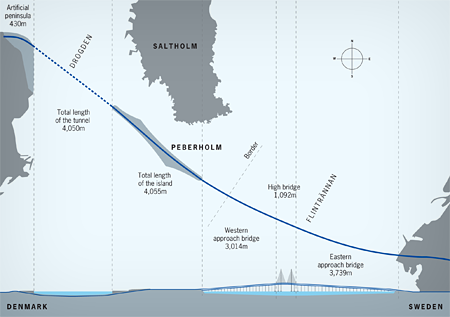Planning and design
The planning and design was a challenging process related to the involvement of two governments (with their own administrative principles, rules and procedures) and concerns about the environment. In the design process many alternatives were created with the emphasis on environmental optimization.
Pre-feasibility
During the years of studies and discussion between the two governments on whether a fixed link should be built, many technical, economic and environmental investigations were carried out.
In 1989 the final results were presented to the two governments, which concluded that there was a general political will in both countries to establish either a railway, or a combined rail- and road link between Copenhagen and Malmö. Further political negotiations in 1990 and 1991 finally led to a government agreement on a fixed link with a combined rail- and road connection should be constructed.
Feasibility
During the first years of the project Øresundskonsortiet faced difficulties obtaining approval from both governments for the design and planning of the project. This was due to differences in administrative principles, rules and procedures between the two governments. Yet, the time-consuming process gave Øresundskonsortiet ample opportunity to develop the organisation, contractual strategies, quality systems and to optimise the design and develop administrative and other procedures.

One of the reasons why this authorities’ approval process was so lengthy and complicated were the environmental requirements. One of the most important of these was the “Zero blocking effect”. This means that the flow of water, salt and oxygen through the Øresund had to remain unchanged. Through careful design and by optimising the length of the tunnel, the size and shape of the artificial peninsula and the island, the flow blocking effect – as computed with sophisticated hydrodynamic models – was reduced from 2.3% of the water flow to 0.5%. During construction, compensation dredging in and around the project area was carried out in order to further reduce the blocking effect to zero. This compensation dredging was carried out in two phases, with the exact amounts and locations of the second phase determined by hydrodynamic modelling after all other marine construction activities had been fixed in the design. In this way the amount of compensation dredging could be kept as small as possible.
Request for proposal
Environmental regulations
The Danish and Swedish authorities stipulated that the construction of the Fixed Link across the Øresund should not affect the marine environment in the Baltic Sea. Øresundskonsortiet developed new strategies and methods to limit environmental effects in the Øresund and the Baltic. Enquiry documents (dredging instructions) were made to translate the environmental regulations to the contractors. One of the main aspects of this document is that the total dredging volume may not exceed 7.5 million cubic meters and spillage must be limited to an average of 5% of the dredged quantities. Furthermore, the extent of spillage must be limited in accordance with seasonal and local conditions. The limit values for spillage of dredged material were described regarding several factors, such as:
- The impact on flora and fauna in the Øresund
- The impact on bathing water along the coast
- The nature of the work and production methods
- Nature and composition of the dredged material
- The actual current conditions
- Experience from projects of similar nature
The limits were determined on the basis of preliminary examinations of the marine environment’s sensitivity to sediment spillage. Although on average spillage from dredging operations may not exceed 5%, spillage may temporarily exceed this value during certain seasons. On the other hand, spillage must be lower during particularly sensitive seasons, i.e. the growth and breeding seasons. Dredging was planned to have a minimum effect on the Øresund environment. For instance, herring migration through the Øresund was carefully monitored in order to avoid barriers of spilt sediment across the Øresund during migration periods.
Consultants tender
In the spring of 1993 the Øresundskonsortiet tendered the engineering, monitoring and supervision services for the fixed link. Apart from the financial part of the tender, the consultant selection was based on a design contest. A number of combinations of consultants were invited to submit a design proposal for the project, based on the reference design of the Øresundskonsortiet derived from the feasibility study. This reference design had to be optimised environmentally and the consultants were invited to present an alternative design, as well. Based on these designs the consultants for the project were chosen.
BwN:
From the start of the project a Triple-P approach was adopted, with the statement that the fixed link should be designed and constructed with due consideration of what is ecologically sound, technically feasible and economically reasonable. From the very start of the project this principle, which is to a large extent in line with the BwN-principles, was adopted and communicated by the actors involved. In the design process many alternatives were created with the emphasis on environmental optimisation.
